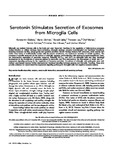Serotonin stimulates secretion of exosomes from microglia cells
| dc.contributor.author | Glebov, Konstantin | |
| dc.contributor.author | Löchner, M | |
| dc.contributor.author | Jabs, R | |
| dc.contributor.author | Lau, T | |
| dc.contributor.author | Merkel, O | |
| dc.contributor.author | Schloss, P | |
| dc.contributor.author | Steinhäuser, C | |
| dc.contributor.author | Walter, J | |
| dc.date.accessioned | 2019-01-30T12:50:59Z | |
| dc.date.available | 2019-01-30T12:50:59Z | |
| dc.date.issued | 2015-04 | |
| dc.identifier.issn | 0894-1491 | |
| dc.identifier.issn | 1098-1136 | |
| dc.identifier.uri | http://hdl.handle.net/10026.1/13242 | |
| dc.description.abstract |
Microglia are resident immune cells in the brain and exert important functions in the regulation of inflammatory processes during infection or cellular damage. Upon activation, microglia undergo complex morphological and functional transitions, including increased motility, phagocytosis and cytokine secretion. Recent findings indicate that exosomes, small vesicles that derive from fusion of multivesicular bodies with the plasma membrane, are involved in secretion of certain cytokines. The presence of specific receptors on the surface of microglia suggests communication with neurons by neurotransmitters. Here, we demonstrate expression of serotonin receptors, including 5-HT2a,b and 5-HT4 in microglial cells and their functional involvement in the modulation of exosome release by serotonin. Our data demonstrate the involvement of cAMP and Ca(2+) dependent signaling pathways in the regulation of exosome secretion. Co-culture of microglia with embryonic stem cell-derived serotonergic neurons further demonstrated functional signaling between neurons and microglia. Together, these data provide evidence for neurotransmitter-dependent signaling pathways in microglial cells that regulate exosome release. | |
| dc.format.extent | 626-634 | |
| dc.format.medium | Print-Electronic | |
| dc.language | en | |
| dc.language.iso | eng | |
| dc.publisher | Wiley | |
| dc.subject | insulin-degrading enzyme | |
| dc.subject | neuron-glia interaction | |
| dc.subject | unconventional secretory pathway | |
| dc.title | Serotonin stimulates secretion of exosomes from microglia cells | |
| dc.type | journal-article | |
| dc.type | Journal Article | |
| dc.type | Research Support, Non-U.S. Gov't | |
| plymouth.author-url | https://www.webofscience.com/api/gateway?GWVersion=2&SrcApp=PARTNER_APP&SrcAuth=LinksAMR&KeyUT=WOS:000349973900007&DestLinkType=FullRecord&DestApp=ALL_WOS&UsrCustomerID=11bb513d99f797142bcfeffcc58ea008 | |
| plymouth.issue | 4 | |
| plymouth.volume | 63 | |
| plymouth.publication-status | Published | |
| plymouth.journal | Glia | |
| dc.identifier.doi | 10.1002/glia.22772 | |
| plymouth.organisational-group | /Plymouth | |
| plymouth.organisational-group | /Plymouth/Faculty of Health | |
| plymouth.organisational-group | /Plymouth/Faculty of Health/Peninsula Medical School | |
| plymouth.organisational-group | /Plymouth/REF 2021 Researchers by UoA | |
| plymouth.organisational-group | /Plymouth/REF 2021 Researchers by UoA/UoA01 Clinical Medicine | |
| plymouth.organisational-group | /Plymouth/Users by role | |
| plymouth.organisational-group | /Plymouth/Users by role/Academics | |
| dc.publisher.place | United States | |
| dcterms.dateAccepted | 2014-11-13 | |
| dc.identifier.eissn | 1098-1136 | |
| dc.rights.embargoperiod | Not known | |
| rioxxterms.versionofrecord | 10.1002/glia.22772 | |
| rioxxterms.licenseref.uri | http://www.rioxx.net/licenses/all-rights-reserved | |
| rioxxterms.licenseref.startdate | 2015-04 | |
| rioxxterms.type | Journal Article/Review |


